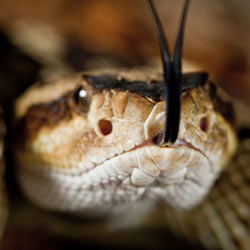Rattlesnake Vaccine for Dogs

Rattlesnakes are venomous serpents that are found throughout North America and elsewhere. They can live in most climates but are especially plentiful in the southwestern United States.
Rattlesnake Facts
Rattlesnakes are pit vipers, which means that they have a small indentation, or pit, between their eye and nostril. This is a sensory organ that detects the heat of the rattlesnake's prey.
Rattlesnakes live in dens, which may be holes in the ground, crevices in rocks, or hollowed logs. In cooler climates, they hibernate during the fall and winter seasons. They are not nocturnal, but in hot weather, they are often more active at night.
A rattlesnake's venom is meant to kill its prey. Most rattlesnakes' venom is hemotoxic. This means that it disrupts the integrity of the victim's blood vessels, resulting in pain, tissue damage, and internal bleeding. If the bite is on the throat or face, the resultant swelling can cause death due to airway closure, as well. Some rattlesnakes have neurotoxic venom, which attacks the nervous system and results in paralysis.
Rattlesnake Bites in Dogs
Dogs are especially prone to rattlesnake bites because they are curious, often nosing around in logs, under rocks and leaves, and in holes in the ground. They may also feel protective of their humans if they come across a rattlesnake during a hike and attack it in defense of their person.
Rattlesnake Treatment in Dogs
The treatment of rattlesnake bite in dogs includes the following:
- Hospitalization
- Administration of antivenin : this is specific to the type of snake that caused the bite
- Antibiotics
- Intravenous fluids
- Pain medications
Many dogs die each year from rattlesnake bites, and many more are permanently injured.
Rattlesnake Vaccine for Dogs
Red Rock Biologics provides a rattlesnake vaccine for dogs. It was approved by the USDA in 2004. This vaccine is designed to help the dog develop antibodies in response to the appearance of rattlesnake venom in the body. These antibodies can result in less pain and tissue damage in the area of the bite, more time to get to a veterinary clinic after a bite, and potentially less need for antivenin and other treatment.
This vaccine protects against the venom of the Western Diamondback rattlesnake. It may provide some degree of cross-protection for the venom of several related rattlesnakes, such as:
- Western rattlesnake
- Sidewinder
- Timber rattlesnake
- Massasauga rattlesnake
- Copperhead
- Eastern Diamondback rattlesnake
This vaccine does not protect against the venom of the water moccasin, Mojave rattlesnake, or Coral snake (Red Rock Biologics).
How Well Does the Rattlesnake Vaccine for Dogs Work?
The vaccine is not fully-protective; it will not completely mitigate the effects of a rattlesnake bite. How well it works for a dog that is bitten by a rattlesnake depends on the type of snake, the amount of venom delivered during the bite, the size of the dog, the size and age of the snake, and the location of the bite. However, dogs that are bitten by the types of rattlesnakes listed above often experience less pain and swelling, and have a faster recovery when they have been previously vaccinated.
Snakebite is always an emergency, even if your dog has received the rattlesnake vaccine. You should take your dog to the veterinarian immediately if he is bitten by a snake of any kind. Your veterinarian will determine whether your dog needs antivenin or any other additional treatment.
Getting the Best Response from Your Dog's Rattlesnake Vaccine
The effectiveness of the rattlesnake vaccine can be increased by adhering to the following guidelines:
- A dog's first dose of rattlesnake vaccine should be given no sooner than four months of age. This is because the safety of the vaccine hasn't been evaluated in puppies younger than that.
- The first time your dog is given the rattlesnake vaccine, it needs to be re-administered, or boosted, in one month. Very small and very large dogs may require a third booster in this initial sequence.
-
The vaccine is most protective about four to six weeks following its administration. Its effectiveness slowly declines after that.
- In areas of the country where rattlesnakes are active for only part of the year, a single vaccine given about one month before the start of the "rattlesnake season" is probably sufficient. This is usually early spring.
- In areas where rattlesnakes are active all year, your veterinarian may recommend boosters every four to six months.
Consider the vaccine even if you do not live in a rattlesnake-endemic area if you plan to take your dog to such an area for a visit or to spend part of the year.
Safety of the Rattlesnake Vaccine in Dogs
This vaccine is licensed for use in dogs in the US. There is a different vaccine licensed for horses. There have not been many side effects reported in conjunction with this vaccine, according to Red Rock Biologics. They report the following side effects:
- Mild swelling at the site of the vaccine injection is possible and resolves on its own.
- More serious allergic reactions resulting in vomiting, diarrhea, and lethargy are even rarer.
- Very serious allergic reactions including anaphylaxis have only been reported in between one and three dogs per million vaccines given.
The rattlesnake vaccine should only be given to healthy dogs. Your veterinarian is best-suited to evaluate whether your dog should receive the vaccine, how many initial boosters he needs, and how often the vaccine should boosted after that.
Tips for Avoiding Rattlesnake Bites in Dogs
A rattlesnake bite is an emergency, whether or not your dog has been vaccinated. Below are some tips to help you avoid rattlesnake bites in your dog:
- Keep your dog on a leash when hiking.
- Avoid areas of tall grass.
- If you come upon a rattlesnake, stay calm and back away slowly with your dog.
- Don't allow your dog to root around in holes in the ground, crevices in rocks, or under brush piles.
- Don't allow your dog to investigate a dead snake. Newly-dead snakes can have muscle reactions that result in bites.
- Don't walk in rattlesnake areas at dusk. In the summertime, snakes are more active just after the sun goes down and at night.
References
- Red Rock Biologics. (n.d.). Rattlesnake Vaccine for Dogs. Retrieved from redrockbiologics.com: www.redrockbiologics.com/rattlesnake_vaccine_ faq.php
You May Also Like These Articles:
How to Prevent Lawn Burn from Dog Urine
How to Be Prepared for Your Dog's Veterinary Bills
Emergency Care for Suspected Poisoning
Disclaimer: This website is not intended to replace professional consultation, diagnosis, or treatment by a licensed veterinarian. If you require any veterinary related advice, contact your veterinarian promptly. Information at DogHealth.com is exclusively of a general reference nature. Do not disregard veterinary advice or delay treatment as a result of accessing information at this site. Just Answer is an external service not affiliated with DogHealth.com.
Notice: Ask-a-Vet is an affiliated service for those who wish to speak with a veterinary professional about their pet's specific condition. Initially, a bot will ask questions to determine the general nature of your concern. Then, you will be transferred to a human. There is a charge for the service if you choose to connect to a veterinarian. Ask-a-Vet is not manned by the staff or owners of DogHealth.com, and the advice given should not delay or replace a visit to your veterinarian.



